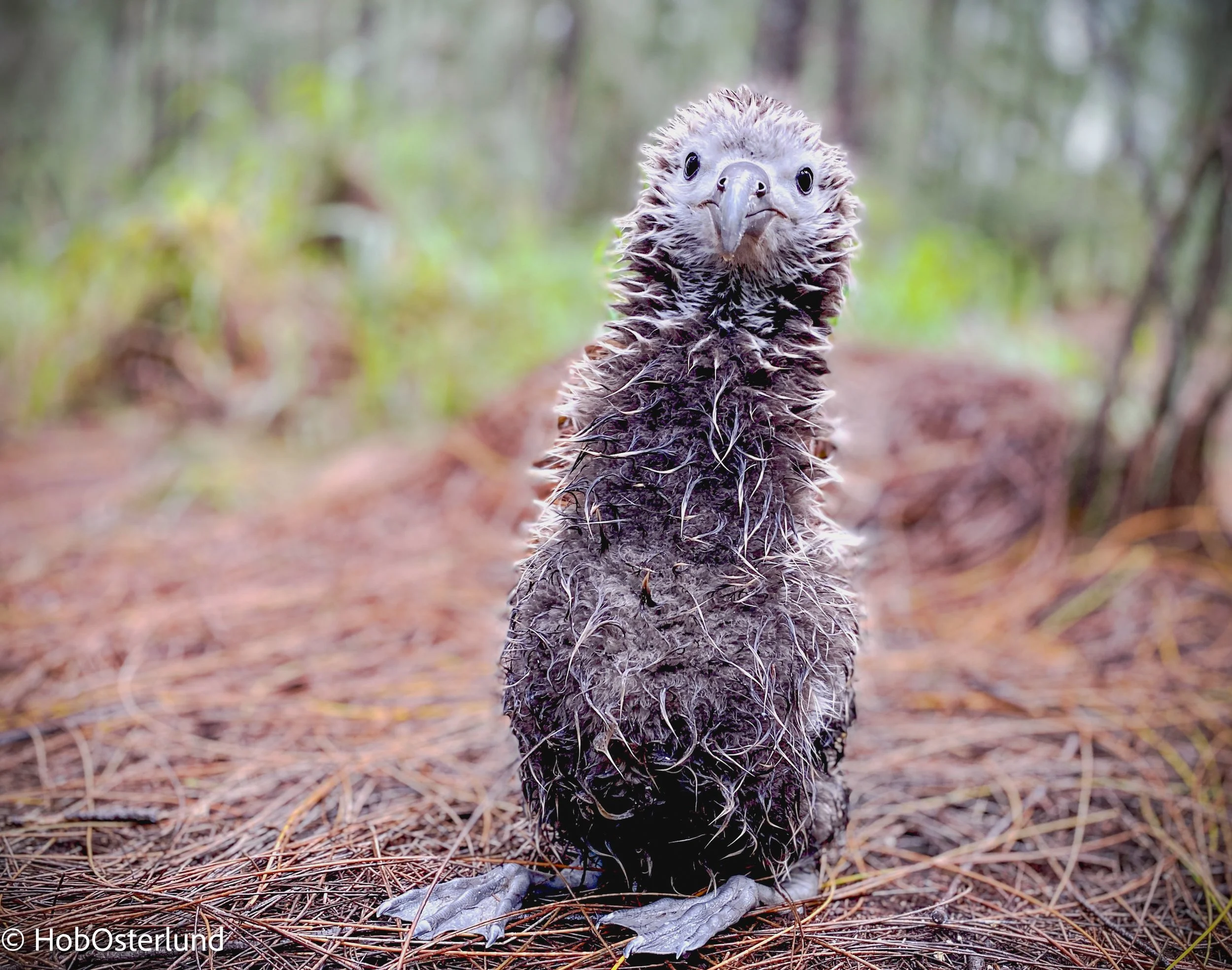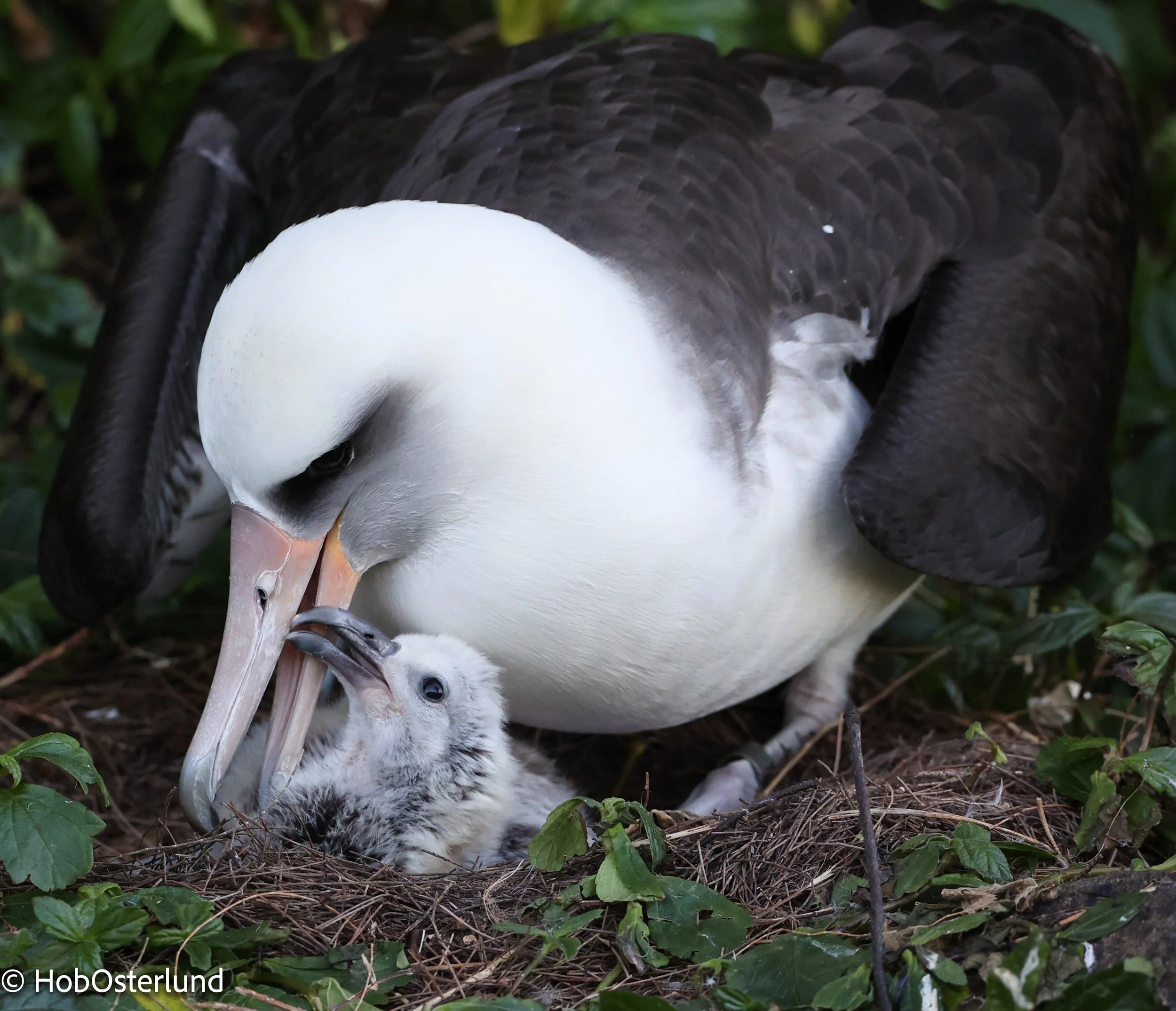Boopsie and the Birds: One Womanʻs Solution to Cat Predation
By Safina Center Conservationist-in-Residence Hob Osterlund
Boopsie in her outdoor “catio”. ©Hob Osterlund
Dr. Anne Thurston is one of those people you find yourself wishing could be miraculously cloned, a million times over. A billion.
Like many of her neighbors on the north shore of Kauaʻi, she’s a big fan of the areaʻs mōlī (Laysan albatross.) She knows itʻs the only place in the world where any species of albatross nests within a sizable human population. Back in 2021, when she found out two freshly-hatched chicks had been killed by feral cats, she was utterly dismayed. “If we were to lose the albatross we would lose a lot of what we have in Princeville, which is a mixed wildlife and settled community,” she said. “We are so very fortunate to have that.”
Laysan albatross chicks are vulnerable to cat predation as soon as they hatch. ©Hob Osterlund
Anne also adores her cat. “Boopsie is a wonderful companion. She anchors me. She offers such a peaceful vibration,” she said.
As fate would have it, in 2022 an albatross pair built a nest under a hedge right next door to Anneʻs home. Since she often allowed Boopsie to roam outdoors, she had to think of a solution. So she sat outside every day, not far from the nest, for a couple of hours at a time. She wanted to be sure the chick came to no harm because of Boopsie. The chick survived to fledge.
Even chicks still under their parents are vulnerable to cats. ©Hob Osterlund
This year a respected neighbor—a former wildlife refuge manager—informed her that trapping had started in an attempt to prevent predation. The feral cat population had grown, and some cats had learned to sense when a chick hatched. Anne trusted her neighbor and was eager to make a plan that protected birds AND Boopsie. “You have to do the work with complete integrity—to the cat, to the environment,” she said. “I had to be more creative in my thinking about this being for whose life I had taken on responsibility,” said Anne, gesturing toward Boopsie. “I had to make a shift. I couldn’t bear it if she were trapped, or if she killed an albatross chick. Neither of those outcomes were acceptable to me.”
Laysan albatross chicks are often left alone at less than two weeks of age. ©Hob Osterlund
Anne was doubly concerned because she had already seen Boopsie go after birds. “Cats hunt, itʻs how theyʻre programmed. I donʻt want to try to unprogram her; I just want her safe. I finally realized I could build a “catio” on my lanai (porch) where she would get a sense of being outdoors, where she could feel the breezes,” she said. Anne asked an acquaintence to build a twenty-five square-foot PVC/chicken wire enclosure. “I went to the thrift shop and bought her some toys. Now sheʻs content in that catio, especially if I sit out there near her some of the time,” Anne said.
Chicks are considered less vulnerable to cat predation at one month of age. ©Hob Osterlund
As it happens, Dr. Thurston had been eager to have her own cat since childhood. She remembers being five years old and lobbying to name the familyʻs pet Tiger, or Rags. Her grandmother, however, had another idea. She named the cat Mr. Grayley, and somehow the formality of his name put a damper on Anne’s connection with the cat.
Her professional life delayed any feline adoption for many decades. She went to George Washington University, earned a PhD, moved to Kenya and worked there for ten years. She then lived in London for another twenty-five years. She created a foundation called International Records Management Trust to support global methods of records and data management. “I was always interested in perserving records as evidence so people could be held accountable,” Anne said. The University of London Press published a book she edited: A Matter of Trust: Building Integrity into Data, Statistics and Records to Support the Sustainable Development Goals. A second text, Integrity in Government Through Records Management was written in her honor. She traveled internationally, up to thirty or forty times a year. What else? Queen Elizabeth II awarded Anne with an Order of the British Empire (OBE) for her services to public administration.
Anne Thurston named an Officer of the British Empire (OBE) by Queen Elizabeth II.
Whew. When Anne finally relocated to Kauaʻi and was later able to stay home long enough, she enlisted a good friend to find a suitable abandoned cat she could adopt. Enter Boopsie. Then covid hit. Not long later Anne fell and broke her hip, had surgery, and needed time to recover. Through all that, her new cat turned out to be the perfect companion. Anne served a role with Boopsie the same way she had served her profession: passionately, steadfastly, and as wholeheartedly as it gets.
Now that Boopsie has acclimated to the catio, and now that predation of albatross chicks has been prevented during the high-risk period this season, what would Anne like to see happen next?
“I understand that these enclosures are common in New Zealand and elsewhere. It would be nice to create some publicity for them and to see various models of catios be posted online,” she said, to encourage other residents to consider a similar option. Information could include plans, costs, where supplies can be purchased, and a list of available builders. “This solution could be very attractive,” she said.
To say the least. And of course, true to her nature, Dr. Thurston then kindly offered to host a public discussion about the topic.
Boopsie surveys her own empire. ©Hob Osterlund
If you are interested in creating your own “catio” or learning more about cat predation of birds, here are some resources:







